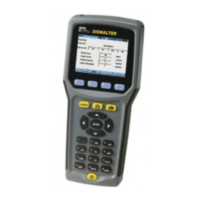SIGNALTEK Operation Manual 1-3
SIGNALTEK Test Functions
SIGNALTEK can perform a variety of both passive and active tests
on communications cable. The passive tests are those where
SIGNALTEK is connected to both ends of the cabling link. Active
tests are those in which one end of the link is connected to an
active network device such as a PC, switch, router or other device
and the opposite end of the link is connected to the SIGNALTEK
handset.
? Wire map – Displays the physical paring of the cable. Also
displays the length of each pair, the condition of the
termination (terminated, open, shorted) and the delay skew
when a Gigabit link is established.
? Link Establishment – Displays the fastest Ethernet speed that
SIGNALTEK was able to establish on the link. When the link is
terminated with a SIGNALTEK remote handset, Link
Establishment will display 10, 100 or 1000 Mbps depending on
the quality of the cabling. When connected to an active LAN
link, Link Establishment will display the fastest speed that was
negotiated with the remote switch/hub/NIC.
? Cable Performance – Displays the BERT data results for links
tested between the SIGNALTEK display and remote handsets.
Information displayed includes: packet size, total number of
packets transmitted, number of packets received, number of
packets with errors, and a percentage bar graph of each.
Note: The setup options allow the Cable
Performance test to be run with default IEEE
802.3 parameters or customized with a user
defined test time and failure threshold.
? VoIP (Voice over IP) Performance – Similar to the Cable
Performance test except that the packets are smaller to
accurately simulate VoIP transmissions.

